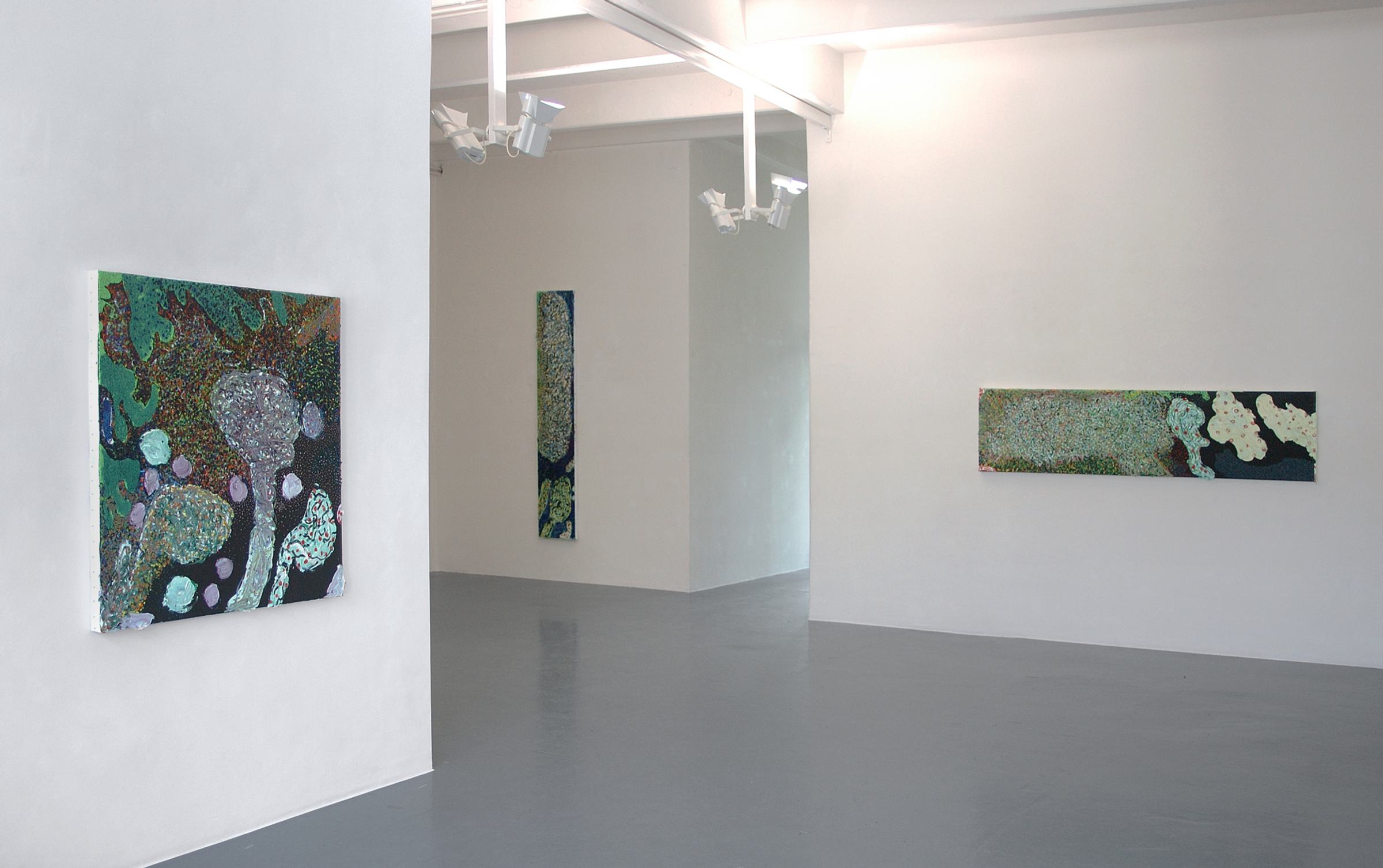Recently I spent a long time looking mainly at one painting in Eli Content's studio. Melancholia: that's how I'll refer to it here. Actually there is more to the title. Also scribbled along the side of canvas is Duke Ellington painting/ sterrennacht/ if you could see me now. As the work was being made and neared its completion, as it became time to think about a title, that's what the painter came up with— those allusions and impressions. But the fact that those words have actually been written so secretively on the side of the work, more or less illegibly, suggests that I needn't really know about them. It seems, after all, fairly evident that this is a predominantly serious and moody painting, not an exuberant one. Look, for instance, closely and carefully at how those flowery, tree-like stumps have been painted: the easy brushstrokes, almost simply one long creeping mass of meanderings which form loops and then, as a tangle, produce a treetop. Because the movement proceeds in this manner, it does slow down— in the loose weave of painted loops. Hidden in the tangles and glistening are, apart from the dots of color, mostly reds and oranges that keep the treetops light and airy. The painting is not exuberant, because the brushstroke indeed meanders yet refrains from swaying or undulating or tossing about. As consequence of this, I notice after a time that I'm looking at the painting more patiently, in a strangely patient and mesmerized way— similar, I think, to the poet’s observation of a butterfly because this is what the delicate, motionless creature asks of him.
There are also paintings in which any commotion is avoided and which, to a greater degree than is normally the case, draw the gaze inward and hold it there— as can be seen here, in the dark and colorful inner twilight of this painting by Eli Content. What I’ve mentioned about the painterly approach to the treetops— that it aims for a peculiarly tranquil concentration— also applies to other areas: to the multicolored haze of teeming brushstrokes and specks, to the empty darkness lit by dots of lilac. What moreover strikes me is that the intent deliberation involved in weaving the ‘haze’ can also be seen in the whimsical but gradual drawing of the green leaf-like forms at the top and on the right. Apart from having other effects, that pattern reminds us that this painting Melancholia, just as most of Content’s work by the way, has developed from landscape-related motifs— though it mainly behaves like a still life in every other respect. It is a landscape in the form of a map, actually, where motifs slip in from the side. First they are drawn on the canvas (which already has a color by then, usually black) in sketchy pencil lines. These lines establish a pattern: within this and around it, that amazingly concentrated process of painting begins. It seems, to me, to be about increasing the refinement of observation in order to see more. In many other paintings, by other painters, the brushstroke may be agitated and energetic, broadly flourishing and then abruptly angular; and looking at the bravura of such paintings is correspondingly exhilarating and restless. The eye roams about. This is how we look at work by Rubens or Tintoretto, because that was how they painted. I look at a painting by Content (and that's the delight, I notice) as though it were a Madonna by Raphael, a gem whose composition has largely been established (no longer having any real surprises) and where the act of painting is a process of refined execution— like music being performed. How velvety, her cheek. It seems to me that Eli Content begins with the whirling (and non-committal) pencil sketch in order to be rid of that problem of the composition. From his truly compelling manner of painting, and from his modulations with color and paint, we can see that the artist did want to arrive at that. The composition (not much more than a division of the surface) is merely the start of things. After that, the act of painting involves another type of devotion. A painter like Content paints because he wishes, while doing so, to see and to discover more of the unbelievable and inimitable variegation in the visible world of color. That is why brushstrokes are decelerated or brought to a halt: as loops, specks, dots—so long as things don’t get muddled, since that makes seeing difficult.
These paintings by Eli Content are therefore veritable spectacles of variegation. The poet Gerard Manley Hopkins (1844-1889) tried, for instance, to achieve such refinement with words. (It does happen to be a bit of an obsession, of course.) Finding words or comparisons was conducive to observation, just as Content’s manner of painting refines and sharpens observation. In the hills of North Wales, this is what Hopkins had seen one summer: As kingfishers catch fire, dragonflies draw flame. An extraordinarily precise observation. Once something like this has been seen and written down, it changes and expands our vision forever. After Van Gogh, the color yellow would never be so benign again. The variegations that Eli Content discovers in his paintings are, too, inimitably precise and movingly beautiful. He did not allow his eye to stray. That’s when he began to see all sorts of things, as he found (encountered) the variety of color while painting. We may observe with him.
Rudi Fuchs
